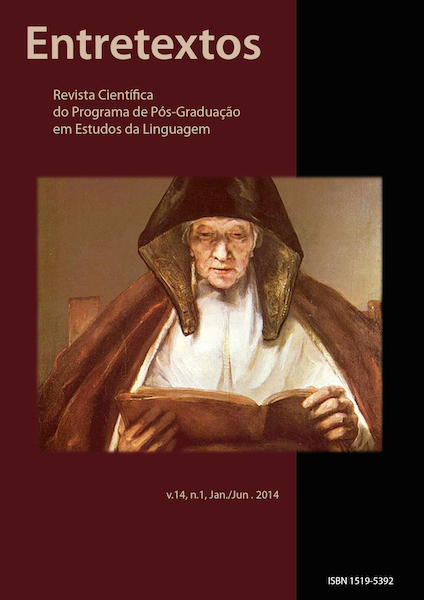The process of words formation with splinters –nese, -nejo and –tone
DOI:
https://doi.org/10.5433/1519-5392.2014v14n1p27Keywords:
Splinters, Blending, Word-formationAbstract
This paper aims at the analysis of the formation of words like, ‘macarronese’, ‘sambanejo’ and ‘chocotone’ process involving the formatives –nese, - nejo and –tone, called ‘splinters’, a term proposed to designate constituents a particular type of word formation process called blending in terms of Sandmann (1997). Based on authors such as Bauer (1983), Algeo (1991), Sandmann (1997), Danks (2003), and others, this present research aims to discuss the status of theses elements that figure in new morphological units through the reanalyze process like ‘ovonese’, ‘sorvetone’, ‘sextaneja’, etc. And seeks to demonstrate that despite the divergence of views among the mentioned authors, the ‘splinters’ presents pattern and regularities when examined in the light of some criteria, e.g., the position occupied by such elements in the output word, applicability, density semantics, etc. The corpus used in this study was collected through electronics tracker as Google, Yahoo as well as varied situation of communication.
Downloads
References
ALGEO, John. Fifty year among the new words. Cambridge: Cambridge University Press. 1991.
BASÍLIO, Margarida. Formação e classe de palavras no português do Brasil. São Paulo: Contexto, 2006.
BAUER, Laurie. English word-formation. Cambridge: Cambridge University Press, 1983.
BAUER, Laurie. Introducing linguistcs morphology. Edinburgh: Edinburgh University Press, 1988.
BAUER, Laurie. The Borderline between Derivation and Compounding. In: W. Dressler et al. (eds.). Morphology and its Demarcations. Amsterdam / Philadelphia: John Benjamins Publishing Company, 2005, p. 97-108.
BAUER, Laurie. A Glossary of Morphology. Washington, DC. Georgetown University Press. 2004.
CANNON, Garland. Blend in English word formation. Linguistics, 24, 1986, p. 725-753.
CHUNG, Karen Steffen. Putting blend in their place. National Taiwan University: Taipei, Taiwan, 2009.
DANKS, Debbie. Separating blends: A formal investigation of the blending process in English and its relationship to associa Ted Word formation processes. 2003. 427f. Thesis (doctor in Philosophy) - University of Liverpool, Liverpool, 2003.
GONÇALVES, Carlos Alexandre; ANDRADE, Kátia Emmerick. O estatuto do constituinte morfológico e o continuum composição-derivação em Português. [S.l.]: [S.n.], 2011.
GONÇALVES, Carlos Alexandre. Composição e Derivação: Polos Prototípicos de um Continuum? Pequeno estudo de casos. Domínios da Lingu@gem, Uberlândia, 2011 a. v 5.
LEHRER, Adrienne. Prefix in English word formation. Folia Linguistica, xxix /1-2, [S.l],1998, p. 133-148.
SANDMANN, Antônio José. Morfologia lexical. São Paulo: Contexto, 1997.
SANDMANN, Antônio José. Morfologia geral. São Paulo: Contexto, 1997.
Downloads
Published
How to Cite
Issue
Section
License
Entretextos adota a Licença Creative Commons Attribution 4.0 International, portanto, os direitos autorais relativos aos artigos publicados são do(s) autor (es).
Sob essa licença é possível: Compartilhar - copiar e redistribuir o material em qualquer suporte ou formato. Adaptar - remixar, transformar, e criar a partir do material, atribuindo o devido crédito e prover um link para a licença e indicar se mudanças foram feitas.




















